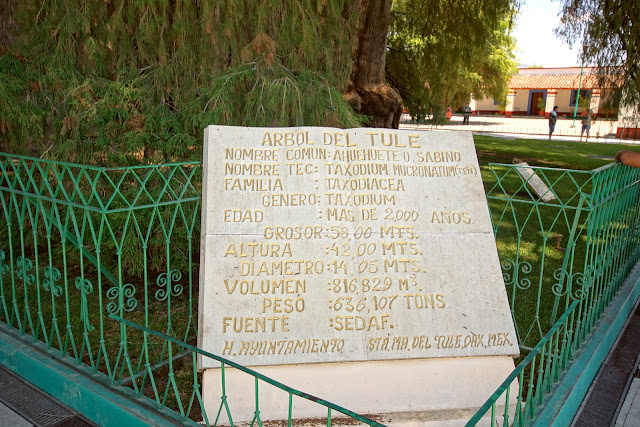I know what you're thinking. It's a big tree, but, I've seen bigger. Well, you're right in a sense; you've almost certainly seen taller but as most women will tell you it's girth that really counts and the locals of the small town of Santa Maria del Tule certainly wouldn't disagree. This is, apparently, the tree with the largest trunk circumference in the world but having said that there are a few things to bear in mind.
1. Any fact that contains the word "apparently" is likely to not be a fact.
2. Small towns in the middle of no where all over the world make claims about having the biggest Something Or Other; this is normally because there is bugger all else going on in town.
3. It's possible that this is actually 2-3 trees that have sort of morphed into one space.
So, bearing all that in mind, let's take a closer look....
So, as you can see, this is a weird looking tree, it's a sort of Joseph Merrick of the tree world. It looks like about twenty trees that have been crudely glued together but, in fairness, it actually is all one organism; DNA tests have proven this, but this doesn't rule out the possibility of one tree having multiple trunks. Where the real controversy lies is how you measure a tree's girth. Do you just walk around the tree with a tape, pull it tight and see what you get or do you tuck the tape into all the nooks and crannies? Or should it actually be based on diameter? In any case, most independent observers seem to agree that it is indeed larger than its nearest competitor, a sequoia.
At the base of this tree can be found this plaque with the vital stats, most of which are wrong. The height is nearer 35 metres and the age is closer to 1,500 years, still very impressive though. The tree is in the churchyard of the small town which is about 9km down the road to Mitla east out of Oaxaca in central Mexico. Sadly, all is not well; the tree is dying. A rapid increase in the local population has severely affected the water table and a busy highway just a few hundred yards away is polluting the air. John Paddock, a US archaeologist specialising in the history of the region has warned local government that if drastic action isn't taken the tree could be dead within fifty years. A sad end to a long life.




hi jason. it's not a hoax by the village or SORT OF the largest circumference of any tree in the world, IT REALLY IS. check the facts. i don't know where you are getting your facts about 1500 years old, but that's not true. it is AT LEAST 2000 years old and that has been confirmed. about the plaque out front, WHO KNOWS, but there is actually historical documentation about the age. AND IT'S NOT A FEW TREES smashed into one. this is all confirmed. if you poke around a bit online you'll find the documentation. THANKS.
ReplyDeleteHi Susan, thanks for your comment.
DeleteOn the whole I agree with you. I think that it probably is all one tree but from what I have read it would appear difficult for this to be proven definitively. I certainly don't think there is any sort of deliberate hoax at work by the local people, but it isn't unheard of for local pride to lead to a bit of exaggeration.
My sources were mainly local papers from the 90s; an analysis by botanist Casiano Conzatti in 1921 entitled "A Monograph on the Tree of Santa Maria del Tule"; and another report from botanist Juan Bolaños.
I must disagree about the age of the tree, though. I couldn't find any good evidence to suggest it was 2,000 years old or greater. Local Zapotec and Mixtec legends say that the tree, along with several others nearby, was planted for the benefit of the people by Pecocha, a representative of the Aztec god of wind and storms, Ehecatl. This story puts the age of the tree at
around fourteen hundred years. This agrees with Casiano Conzatti's scientific analysis. If you could point me in the direction of the documents you mention I would be very interested to read them.
I hope this helps,
Thanks,
Jason